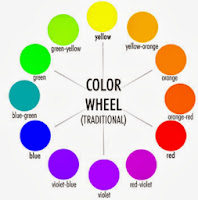Third graders began to fill their canvases with color today and learned about color theory in the process. We applied paint to our faces, neck and ears, being very careful to circle around the eyes and mouth. Once the face was complete, we began working on the background.
For inspiration, we looked at Vincent van Gogh's self portrait that hangs in my art room. We studied the swirls of colors he applied to his background and noticed how this fills his painting with texture, movement, and interest. Vincent used swirls of green and lavender over his light blue background. These colors are all close to each other on the color wheel so they blend well visually and create a subtle design.
To see more Vincent van Gogh paintings and appreciate his ability to use his brush to add detail and movement, check out this link to the Van Gogh Museum. This site has a gallery of over 150 paintings by Vincent van Gogh and you are able to zoom in on any painting to examine each brush stroke and every small detail.
http://www.google.com/culturalinstitute/collection/van-gogh-museum?projectId=art-project
Note to families . . .
This art blog will be updated regularly with new posts sharing our daily activities in the art room and news about upcoming art exhibits. To respect the privacy of our students, names will always be limited to first name only and identifiable photos will never be accompanied with a name. If you have any questions or comments, please feel free to write in the comment box below or send me an email at blevine@ranneyschool.org. I would love to hear from you!
In my class, students are given the chance to explore different materials and fun new techniques as they develop their signature style. Some young artists love to draw with a pencil, some like to paint on canvas or create images in a digital format, while others prefer working with clay and molding three-dimensional forms. In my classroom, we use a variety of materials allowing all artists to experiment and figure out which type of art they like the best. At Ranney School, we place a strong emphasis on originality and celebrate artistic differences, always nurturing and encouraging the imagination of every student.
Remember to check out our display of finished artwork and student portfolios in the Ranney home page of Artsonia.com. http://www.artsonia.com/schools/school.asp?id=114839








